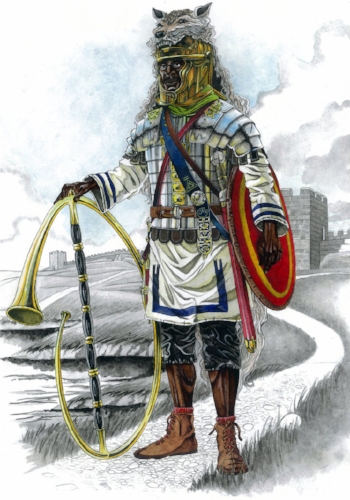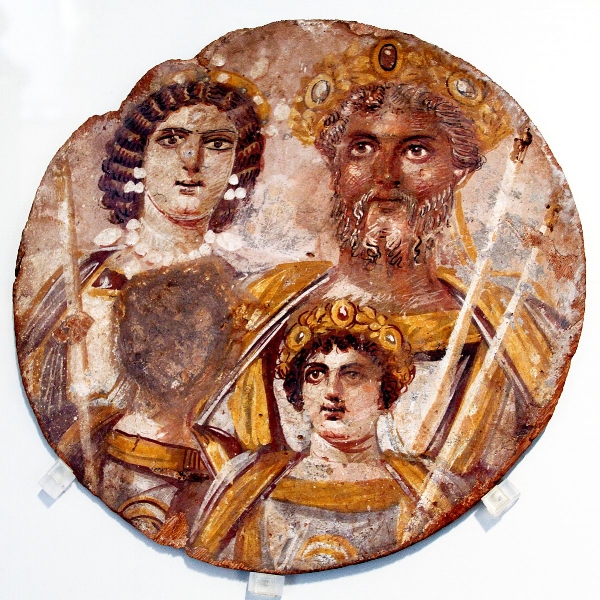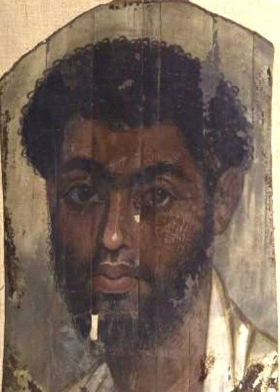A black legionary cornicen on the northern frontier, c.AD200. Illustration by Pavel Šimák.
The question of whether black Africans served in the Roman army comes up with surprising frequency on social media. It’s a contentious topic, related to various contemporary debates about ethnicity, multiculturalism, and the representation of history. Often these discussions generate considerably more heat than light, but as I was recently asked about an African centurion who appeared in my first novel, War at the Edge of the World, I though I might share a few thoughts about one of the few scraps of evidence we possess for the ethnicity of Roman soldiers.
In AD208, towards the end of his life, the elderly and gout-afflicted emperor Septimius Severus came to Britain for a last campaign against the rebellious peoples north of Hadrian’s Wall. Two years later, with no clear victory in sight, he died at York; but in the months before his death he apparently experienced several grim omens. The Historia Augusta, a much later account of various imperial lives, preserves an unusual anecdote from the emperor’s stay in the north:
"After inspecting the wall near the rampart in Britain… just as he [Severus] was wondering what omen would present itself, an Ethiopian from a military unit, who was famous among buffoons and always a notable joker, met him with a garland of cypress. And when Severus in a rage ordered that the man be removed from his sight, troubled as he was by the man's ominous colour and the ominous nature of the garland, [the Ethiopian] by way of jest cried, it is said, “You have been all things, you have conquered all things, now, O conqueror, be a god.” "
(Post murum apud vallum visum in Brittannia… volvens animo quid ominis sibi occurreret, Aethiops quidam e numero militari, clarae inter scurras famae et celebratorum semper iocorum, cum corona e cupressu facta eidem occurrit. quem cum ille iratus removeri ab oculis praecepisset, et coloris eius tactus omine et coronae, dixisse ille dicitur ioci causa: Totum fuisti, totum vicisti, iam deus esto victor.)
(Historia Augusta, ‘Septimius Severus’, 22.4-5)
The Historia Augusta is generally regarded today as only partially reliable at best, but even if the event is fictitious, it must at least have been believable. This suggests that it may indeed have been possible to encounter a black soldier serving in the Roman army in northern Britain in AD210, although we can gather from the emperor’s reaction that it would not have been a common occurrence!
The Roman empire was both cosmopolitan and multi-ethnic, drawing in people from every territory within and adjacent to its domains, and in most cases turning them into citizens. This was certainly true of the army, just as it was of the aristocracy; for centuries, Rome had been absorbing the ruling elites of conquered nations and ‘rewarding’ them with access to the senatorial order.
Severus himself was a product of this cultural and political cross-pollination. Born in Leptis Magna, in today’s Libya, his family were of Punic (Carthaginian/Lebanese) background, and had gained Roman citizenship long before. His wife Julia Domna was Syrian, and a family portrait of c.AD200 shows the couple with their two sons – the second son’s face was obliterated some time later after his brother Caracalla murdered him and tried to erase him from history. The portrait shows Severus with a darker or ruddier complexion than his Syrian wife and son.
But the Romans had different ideas about ethnicity and geographical origins to those most common today, and often we have no way of distinguishing different ethnic groups, still less different complexions, from literary evidence. The ethnic marker Afer (‘African’), for example, which appears on tombstones, refers strictly to people from the region around Carthage, in modern Tunisia. The Roman term for someone of black African origin was Aethiops – ‘Ethiopian’. So while Severus could be described as an African, we can see from the anecdote about the black soldier in Britain that he could not have been Aethiops himself.
A Romano-Egyptian mummy portrait from Fayum, 2nd-3rd century AD
As the term suggests, the principal route of entry for black Africans into the empire would be via the Nile valley and Egypt. Alexandria, in particular, was famously cosmopolitan and multi-ethnic, and had a black population long before the arrival of the Romans. The 4th-century historian Ammianus Marcellinus describes the Egyptians of his own time as ‘swarthy and dark of complexion’. However, not all black Africans came from Egypt; Ammianus also mentions, in passing, that tribes of Aethiopi lived near Auzia in the province of Mauretania Caesariensis (modern Sour el-Ghozlane, in Algeria): there were trade routes across the Sahara into North Africa at the time, and historians have only recently begun to study the possible cultural and ethnic connections in this area.
However, for all the evidence of black Africans living throughout the Roman empire, we should not believe that ancient peoples were necessarily ‘colour blind’, or free from prejudices about ethnicity. On the contrary; it seems that many Romans were distinctly prejudiced against black people in particular. Black Africans were seen as exotic, and perhaps threateningly alien, and they are seldom if ever mentioned in Roman literature without some negative connotation. Most disturbingly, the historian Appian claims that the military commander Brutus, before the battle of Philippi in 42BC, met an ‘Ethiopian’ outside the gates of his camp: his soldiers instantly hacked the man to pieces, taking his appearance for a bad omen – to the superstitious Roman, black was the colour of death.
This brings us back to the story in the Historia Augusta about Severus meeting the black soldier in Britain. Like the funereal cypress garland he carried, the soldier’s appearance seemed to the emperor an intimation of his own approaching demise. To be scrupulous, we should perhaps note that the text does not clearly refer to the man as a soldier – he was Aethiops quindam e numero militari: 'an Ethiopian from a military unit'. Nevertheless, he was most probably an enlisted man – 3rd-century evidence from Dura Europos on the eastern frontier and Lyons in Gaul suggests that military men could have additional roles as actors or entertainers (scaenici), but the term scurrus famae may simply have meant that he was well known among his fellow soldiers for his sense of humour!
Some historians have suggested that the Ethiopian could have been serving with the Numerus Maurorum Aurelianorum, a ‘Moorish’ unit stationed at Burgh-by-Sands near the western end of Hadrian’s Wall in the later Roman era. This too is plausible, although the unit is first attested in Britain in the mid 3rd-century, so we do not know if it existed, or was anywhere near Hadrian’s Wall, back in Severus’s day.
North African light cavalry in action, as portrayed on Trajan’s Column in Rome, cAD110
But there may have been plenty of other routes for a man of black African origin to find himself in a military unit in the north of Britain in AD210. Detachments of legions and other forces were often sent from one province to another, sometimes over great distances, and we have evidence of men apparently recruited in North Africa turning up in Britain in the later second century.
The legions II Traiana and III Augusta, based in Egypt and Numidia respectively, appear to have been used as a pool for reinforcements throughout imperial history; they alone would have contributed to a wide ethnic diffusion through the army more generally. And then, of course, there are the auxiliary forces, raised from inhabitants of the frontier provinces and given citizenship on discharge.
The irregular North African light cavalry who appear on Trajan’s Column may have a rather idealised appearance - and it is not entirely clear what the sculptor intended their ethnicity to be, beyond generically 'African' - but they certainly imply that, for all the prejudices of the metropolitan Roman, the army was far more accepting of diversity!
Our evidence would suggest, then, that the black African centurion Rogatianus who appears in War at the Edge of the World, himself a recent transfer to Britain, would probably not have been so unusual in the Roman army of the early 4th-century AD. But our vision of the ancient past is necessarily fragmented and partial; history, the method we use to try and assemble those fragments and reconstruct what they might have shown, is constantly changing. Fiction provides one way of trying to imagine what the past might have looked like, in all its unexpected variety. So whether it’s the colour of Roman soldiers, or just the colour of Roman tunics, the debates will no doubt continue.
A Biblical scene from the 6th-7th century Ashburnham/Tours Pentateuch; the figures are dressed in typical late Roman style.





